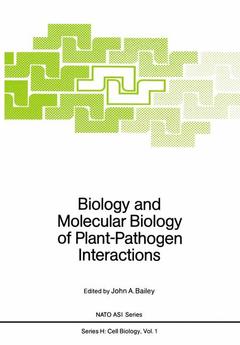Description
Biology and Molecular Biology of Plant-Pathogen Interactions, Softcover reprint of the original 1st ed. 1986
Nato ASI Subseries H: Series, Vol. 1
Coordinator: Bailey John A.
Language: English
Subjects for Biology and Molecular Biology of Plant-Pathogen Interactions:
Keywords
Publication date: 02-2012
415 p. · 17x24.4 cm · Paperback
415 p. · 17x24.4 cm · Paperback
Description
/li>Contents
/li>
This book is a collection of papers presented at a NATO Advanced Research Workshop on "Biology and Molecular Biology of Plant-Pathogen Interactions" which was held at Dillington College, Ilminster, UK, 1-6 September 1985. It had been preceded by Advanced Study Institutes at Porte Conte, Sardinia in 1975 and at Cape Sounion, Greece in 1981. In recent years, methods for the manipulation and transfer of genes have revolutionized our understanding of gene structure and function. It was thus opportune to bring together scientists from distinct disciplines, e. g. plant pathology, cytology, biochemistry and molecular biology to discuss our present understanding of cellular interactions between plants. We also explored how the potential offered by the newer molecular technologies could best be realized. It soon became evident at the Workshop, and is a repeated theme of this publication, that future research will need concentrated multi disciplinary programmes. Many of the new approaches will be valuable. For example, immunocytochemistry does, for the first time, allow molecules to be located precisely within infected tissues. Equally, the methods of DNA isolation and gene transformation will facilitate the isolation and characterization of genes associated with pathogenesis and specificity. The description at the Workshop of immunocytochemical protocols and of transformation systems for pathogenic fungi have already stimulated an upsurge in research on plant-pathogen relationships. The papers discuss many interactions between plants and fungal and bacterial pathogens, but also provide a comparison with mycorrhizal and symbiotic relationships, and those involving mycoparasites.
Introductory Comments On Host-Parasite Interactions.- Biology of Plant-Fungus Interactions.- Fundamental Questions Related to Plant-Fungal Interactions: Can Recombinant DNA Technology Provide the Answers?.- Cellular Modifications during Host-Fungus Interactions in Endomycorrhizae.- Cellular Interactions between Phaseolus vulgaris and the Hemibiotrophic Fungus Colletotrichum lindemuthianum.- Ultrastructural Localization of Carbohydrates. Recent Developments in Cytochemistry and Affinity Methods.- Attachment of a Mycoparasite with Host but not with Nonhost Mortierella Species.- Biology of Plant Bacterial Interactions.- The Biology of Interactions between Plants and Bacteria.- Surface Interactions between Rhizobium and Infected Pea Root Nodule Cells, as Revealed by using Monoclonal Antibodies.- Mechanisms of Resistance.- Biochemical Mechanisms Involved in Resistance of Plants to Fungi.- Cell Wall Modifications Associated with the Resistance of Cereals to Fungal Pathogens.- Mechanism of Resistance of Wheat against Stem Rust in the Sr5/P5 Interaction.- Elicitation of Resistance.- Elicitation of Active Resistance Mechanisms.- Evidence for both Induced Susceptibility and Induced Resistance in the Cladosporium fulvum — Tomato Interaction.- Do Galacturonic Acid Oligosaccharides have a Role in the Resistance Mechanism of Cucumber towards Cladosporium cucumerinum?.- Carbohydrate and Lipid-Containing Elicitors from Phytophthora infestans. Do they have a Common Mechanism of Action?.- Differential Elicitation Activities of Fractions from Phytophthora spp. on Several Host-Plants.- Regulation of Steroid Glycoalkaloid and Sesquiterpenoid Stress Metabolite Accumulation in Potato Tubers by Inhibitors of Steroid Synthesis and Phytohormones in Combination with Arachidonic Acid.- Elicitation and Suppression of Necrosis in Potato Leaves by Culture Filtrate Components of Phytophthora infestans.- Molecular Biology of Plant Responses.- Organization, Structure and Activation of Plant Defence Genes.- Molecular Targets for Elicitor Modulation in Bean (Phaseolus vulgaris) Cells.- Accumulation of Hydroxyproline-Rich Glycoprotein mRNAs in Biologically Stressed Cell Cultures and Hypocotyls.- Biochemical Study of Hydroxyproline-Rich Glycoproteins in Plant-Pathogen Interactions.- Biochemical Responses of Non-Host Plant Cells to Fungi and Fungal Elicitors.- Pea Genes Associated with the Non-Host Resistance to Fusarium solani are also Induced by Chitosan and in Race-Specific by Pseudomonas syringae.- Race Variable Macromolecules Identified in Puccinia graminis f.sp. tritici; Correlations with Avirulence/Virulence to Host Genes for Resistance.- Molecular Biology of Bacterial Pathogenesis.- The Molecular Biology of Pectic Enzyme Production and Bacterial Soft Rot Pathogenesis.- Molecular Genetics of Pathogenicity of Xanthomonas campestris.- Genetic Control of Hypersensitivity and Pathogenicity in Pseudomonas syringae pv. phaseolicola.- Regulation of Bacterial Genes Involved in Bacterium-Plant Interactions by Plant Signal Molecules.- Indoleacetic Acid and Cytokinins in the Olive Knot Disease. An Overview of their Role and their Genetic Determinants.- Molecular Biology of Fungal Pathogenesis.- Gene Expression during Infection Structure Development by Germlings of the Rust Fungi.- Isolation of Stage- And Cell-Specific Genes from Fungi.- An Antibiotic Resistance Marker for Fungal Transformation.- Analysis of Transcription — Control Signals in Aspergillus.- Technology for Molecular Cloning of Fungal Virulence Genes.- Molecular Evolution of Fungal Polygalacturonase.- The D2-Factor in Ophiostoma ulmi: Expression and Latency.- The Effects of Passaging on the Host Specificity of Septoria nodorum: A Cautionary Tale.- Participants.
© 2024 LAVOISIER S.A.S.
These books may interest you

Active Defense Mechanisms in Plants 105.49 €



